Fractions can be one of the most frustrating topics to teach to elementary school children. Linking the experience of your students with fractions in their daily lives to fractions in the classroom can make this task easier. Young children have early experiences with the concept of fractions when they want to share a sandwich with a friend. They know that if they have a sandwich that is cut in two parts they can share it by keeping half for themselves and giving the other half to their friend. This experience gives them the foundation for the concept that a fraction is part of a whole. The concept can be expanded if you talk about pizza. The average medium pizza has eight slices. This allows you to talk about the fact that one slice is one-eighth of the pizza. This allows the students to have a real world link as you teach more difficult concepts in fractions. Real world connections will not work for all of the concepts that need to be taught about fractions so using hands on activities will work well.
The remainder of this article will provide you with suggestions on how to use pattern blocks to show students how fractions are parts of a whole. In the event that pattern blocks are not available in your school here are two links that may help you use this concept. If computers are available, this link takes you to an online pattern block simulator. If computers aren’t available, this site will give you printable masters to make your own pattern blocks. I would suggest printing them on construction paper in colors that match real pattern blocks. An easy homework assignment would be to send the papers home to be cut out and returned for use in the classroom.
Research shows that about 65% of students today are visual learners so hands-on activities work well when teaching mathematics. Using pattern blocks to show that fractions are representations of parts of a whole has the added advantage of reinforcing the proper terms for the shapes of each piece, reinforcing some geometry as you teach fractions. Pattern blocks also work well in learning groups so students can discover concepts while working with their group to experience parts of a whole with pattern blocks. Provide each group with a set of pattern blocks.
If this is the first time that your students are using this item, allow them about five minutes just to “play” with the blocks. It will save you trouble when you begin the formal lesson. Have students place the hexagons, triangles, trapezoids, and rhombuses in the center of the group. The hexagon will represent the whole for this activity. Instruct the groups to use the hexagon as a base on which to work. Beginning with the trapezoids, students should see if they can cover the hexagon with trapezoids. They should repeat this activity with the triangles and rhombuses:
[fusion_builder_container hundred_percent=”yes” overflow=”visible”][fusion_builder_row][fusion_builder_column type=”1_1″ background_position=”left top” background_color=”” border_size=”” border_color=”” border_style=”solid” spacing=”yes” background_image=”” background_repeat=”no-repeat” padding=”” margin_top=”0px” margin_bottom=”0px” class=”” id=”” animation_type=”” animation_speed=”0.3″ animation_direction=”left” hide_on_mobile=”no” center_content=”no” min_height=”none”]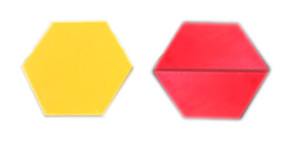
[/fusion_builder_column][fusion_builder_column type=”1_1″ background_position=”left top” background_color=”” border_size=”” border_color=”” border_style=”solid” spacing=”yes” background_image=”” background_repeat=”no-repeat” padding=”” margin_top=”0px” margin_bottom=”0px” class=”” id=”” animation_type=”” animation_speed=”0.3″ animation_direction=”left” hide_on_mobile=”no” center_content=”no” min_height=”none”]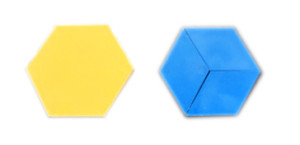
[/fusion_builder_column][fusion_builder_column type=”1_1″ background_position=”left top” background_color=”” border_size=”” border_color=”” border_style=”solid” spacing=”yes” background_image=”” background_repeat=”no-repeat” padding=”” margin_top=”0px” margin_bottom=”0px” class=”” id=”” animation_type=”” animation_speed=”0.3″ animation_direction=”left” hide_on_mobile=”no” center_content=”no” min_height=”none”]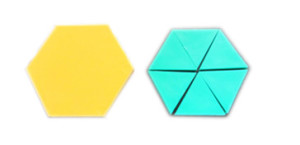
Bring the entire class back together and have them help you fill in the following chart:
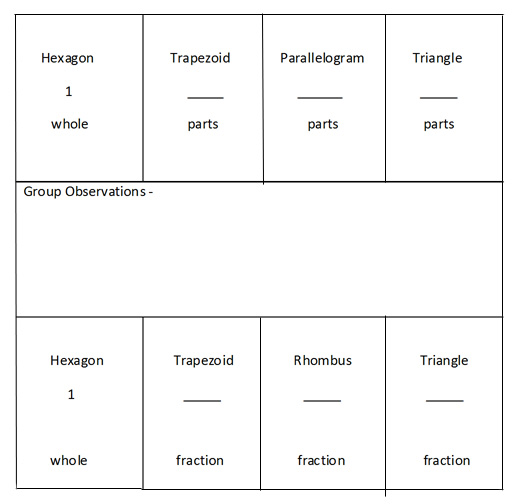
Have the students use the pattern blocks to see if they can use any other shape as the base and cover that shape with other blocks. The full class can then add any findings they have to the worksheet that has been started.
[/fusion_builder_column][fusion_builder_column type=”1_1″ background_position=”left top” background_color=”” border_size=”” border_color=”” border_style=”solid” spacing=”yes” background_image=”” background_repeat=”no-repeat” padding=”” margin_top=”0px” margin_bottom=”0px” class=”” id=”” animation_type=”” animation_speed=”0.3″ animation_direction=”left” hide_on_mobile=”no” center_content=”no” min_height=”none”]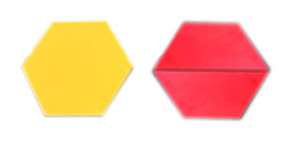
[/fusion_builder_column][fusion_builder_column type=”1_1″ background_position=”left top” background_color=”” border_size=”” border_color=”” border_style=”solid” spacing=”yes” background_image=”” background_repeat=”no-repeat” padding=”” margin_top=”0px” margin_bottom=”0px” class=”” id=”” animation_type=”” animation_speed=”0.3″ animation_direction=”left” hide_on_mobile=”no” center_content=”no” min_height=”none”]
When the groups finish this investigation and share their findings you can then move on to writing the fractional notation for their discoveries and the class can then fill in the last part of their chart. If you feel that your class has understood the work so far you may want to ask them questions like – 1. What fraction of the hexagon is 1 trapezoid? 2. What fraction of the hexagon is 1 rhombus? In conclusion, whether you are using a mathematics program or a traditional text, the activities I have presented here can work well as a supplement or as a homework assignment. Look for additional articles on teaching fractions using hands on materials during the next few weeks.[/fusion_builder_column][/fusion_builder_row][/fusion_builder_container]

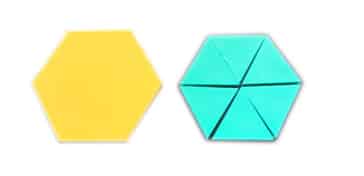




Leave a comment